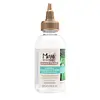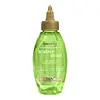What's inside
What's inside
 Key Ingredients
Key Ingredients

 Benefits
Benefits

 Concerns
Concerns

 Ingredients Side-by-side
Ingredients Side-by-side

Aloe Barbadensis Leaf Juice
Skin ConditioningWater
Skin ConditioningGlycerin
HumectantPropanediol
SolventPEG-40 Hydrogenated Castor Oil
EmulsifyingPolysorbate 20
EmulsifyingRosmarinus Officinalis Leaf Oil
MaskingTocopheryl Acetate
AntioxidantCocos Nucifera Water
MaskingTetraselmis Suecica Extract
Skin ConditioningNigella Sativa Seed Oil
EmollientOpuntia Ficus-Indica Seed Oil
EmollientAdansonia Digitata Seed Oil
EmollientCocos Nucifera Seed Butter
Skin ConditioningButyrospermum Parkii Butter
Skin ConditioningCalophyllum Inophyllum Seed Oil
AntimicrobialMoringa Oleifera Seed Oil
EmollientCaprylyl Glycol
EmollientHydroxyphenyl Propamidobenzoic Acid
Skin ConditioningPEG-5 Ethylhexanoate
EmulsifyingTrideceth-9
EmulsifyingMannitol
HumectantCarrageenan
Xanthan Gum
EmulsifyingTetrasodium Glutamate Diacetate
Hydroxyacetophenone
AntioxidantParfum
MaskingAloe Barbadensis Leaf Juice, Water, Glycerin, Propanediol, PEG-40 Hydrogenated Castor Oil, Polysorbate 20, Rosmarinus Officinalis Leaf Oil, Tocopheryl Acetate, Cocos Nucifera Water, Tetraselmis Suecica Extract, Nigella Sativa Seed Oil, Opuntia Ficus-Indica Seed Oil, Adansonia Digitata Seed Oil, Cocos Nucifera Seed Butter, Butyrospermum Parkii Butter, Calophyllum Inophyllum Seed Oil, Moringa Oleifera Seed Oil, Caprylyl Glycol, Hydroxyphenyl Propamidobenzoic Acid, PEG-5 Ethylhexanoate, Trideceth-9, Mannitol, Carrageenan, Xanthan Gum, Tetrasodium Glutamate Diacetate, Hydroxyacetophenone, Parfum
Water
Skin ConditioningPolysorbate 20
EmulsifyingMelaleuca Alternifolia Leaf Oil
AntioxidantMentha Piperita Leaf Extract
Skin ConditioningHamamelis Virginiana Leaf Extract
Skin ConditioningMenthol
MaskingMenthyl Lactate
MaskingEthyltrimonium Chloride Methacrylate/Hydrolyzed Wheat Protein Copolymer
Polyquaternium-10
Cocamidopropyl Betaine
CleansingGlycerin
HumectantPropylene Glycol
HumectantSodium Hydroxide
BufferingCitric Acid
BufferingSodium Chloride
MaskingLactic Acid
BufferingPhenoxyethanol
PreservativeCaprylyl Glycol
EmollientParfum
MaskingWater, Polysorbate 20, Melaleuca Alternifolia Leaf Oil, Mentha Piperita Leaf Extract, Hamamelis Virginiana Leaf Extract, Menthol, Menthyl Lactate, Ethyltrimonium Chloride Methacrylate/Hydrolyzed Wheat Protein Copolymer, Polyquaternium-10, Cocamidopropyl Betaine, Glycerin, Propylene Glycol, Sodium Hydroxide, Citric Acid, Sodium Chloride, Lactic Acid, Phenoxyethanol, Caprylyl Glycol, Parfum
Ingredients Explained
These ingredients are found in both products.
Ingredients higher up in an ingredient list are typically present in a larger amount.
Caprylyl Glycol is a humectant and emollient, meaning it attracts and preserves moisture.
It is a common ingredient in many products, especially those designed to hydrate skin. The primary benefits are retaining moisture, skin softening, and promoting a healthy skin barrier.
Though Caprylyl Glycol is an alcohol derived from fatty acids, it is not the kind that can dry out skin.
This ingredient is also used as a preservative to extend the life of products. It has slight antimicrobial properties.
Learn more about Caprylyl GlycolGlycerin is already naturally found in your skin. It helps moisturize and protect your skin.
A study from 2016 found glycerin to be more effective as a humectant than AHAs and hyaluronic acid.
As a humectant, it helps the skin stay hydrated by pulling moisture to your skin. The low molecular weight of glycerin allows it to pull moisture into the deeper layers of your skin.
Hydrated skin improves your skin barrier; Your skin barrier helps protect against irritants and bacteria.
Glycerin has also been found to have antimicrobial and antiviral properties. Due to these properties, glycerin is often used in wound and burn treatments.
In cosmetics, glycerin is usually derived from plants such as soybean or palm. However, it can also be sourced from animals, such as tallow or animal fat.
This ingredient is organic, colorless, odorless, and non-toxic.
Glycerin is the name for this ingredient in American English. British English uses Glycerol/Glycerine.
Learn more about GlycerinParfum is a catch-all term for an ingredient or more that is used to give a scent to products.
Also called "fragrance", this ingredient can be a blend of hundreds of chemicals or plant oils. This means every product with "fragrance" or "parfum" in the ingredients list is a different mixture.
For instance, Habanolide is a proprietary trade name for a specific aroma chemical. When used as a fragrance ingredient in cosmetics, most aroma chemicals fall under the broad labeling category of “FRAGRANCE” or “PARFUM” according to EU and US regulations.
The term 'parfum' or 'fragrance' is not regulated in many countries. In many cases, it is up to the brand to define this term.
For instance, many brands choose to label themselves as "fragrance-free" because they are not using synthetic fragrances. However, their products may still contain ingredients such as essential oils that are considered a fragrance by INCI standards.
One example is Calendula flower extract. Calendula is an essential oil that still imparts a scent or 'fragrance'.
Depending on the blend, the ingredients in the mixture can cause allergies and sensitivities on the skin. Some ingredients that are known EU allergens include linalool and citronellol.
Parfum can also be used to mask or cover an unpleasant scent.
The bottom line is: not all fragrances/parfum/ingredients are created equally. If you are worried about fragrances, we recommend taking a closer look at an ingredient. And of course, we always recommend speaking with a professional.
Learn more about ParfumPolysorbate 20 is made by combining ethoxylation of sorbitan, ethylene oxide, and lauric acid. It is a mild cleansing agent, surfactant, and emulsifier.
As a surfactant, it helps collect dirt and oils for washing. Emulsifiers prevent oils and water from separating.
Polysorbate 20 also adds scent to a product. Since it is made using sorbitol, it has a sweet scent. Sorbitol can also be found in fruits such as apples and peaches.
The lauric acid used to create Polysorbate 20 is often derived from coconuts.
Polysorbate 20 may not be fungal acne safe.
Learn more about Polysorbate 20Water. It's the most common cosmetic ingredient of all. You'll usually see it at the top of ingredient lists, meaning that it makes up the largest part of the product.
So why is it so popular? Water most often acts as a solvent - this means that it helps dissolve other ingredients into the formulation.
You'll also recognize water as that liquid we all need to stay alive. If you see this, drink a glass of water. Stay hydrated!
Learn more about Water